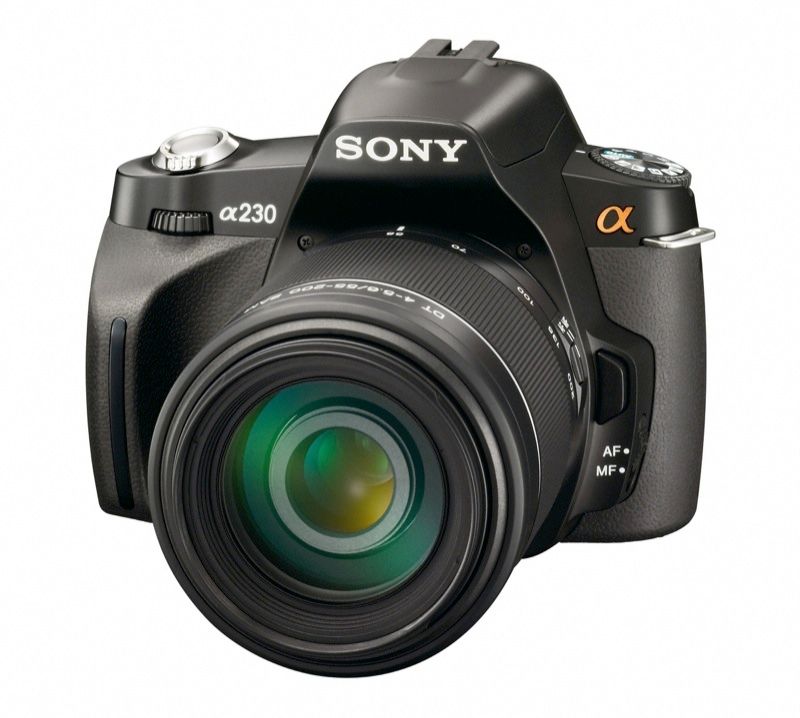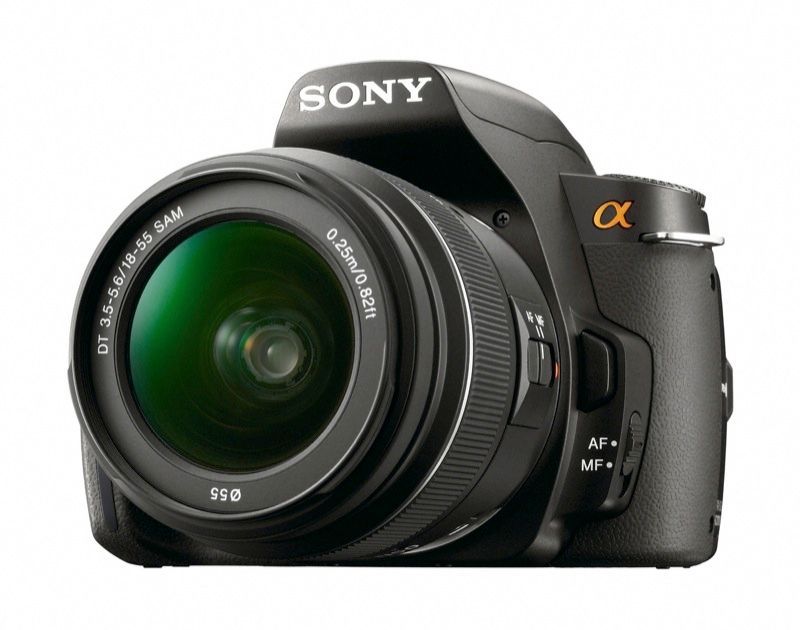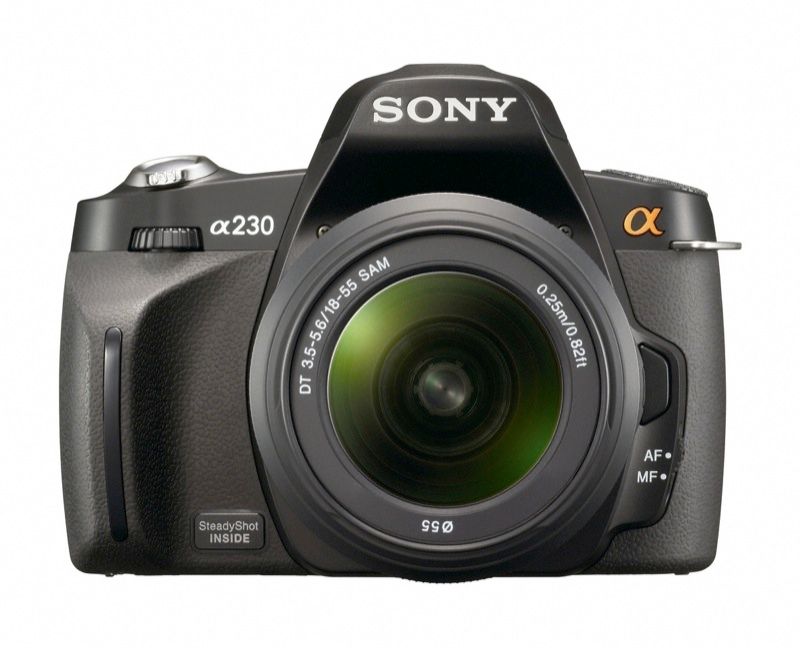Since it launched its initial Alpha A100 in 2006, Sony has slowly but steadily increased the breadth of its DSLR range, inserting models here and there until there is barely any difference between neighbouring Alpha units - the aim of course being increased market share.
Our quick take
Though it may be the current runt of the Alpha family, the A230 doesn't prove a pig to use, in spite of our grumbles about the too small grip and lack of Live View. With large, well spaced controls - big buttons and chunky mode and command dials - it offers a beginner friendly and inexpensive route into DSLR ownership for those looking to get more professional results than their compact camera or mobile phone can ever provide.
The kit lens is also impressively sharp given clear, ideal shooting conditions, displaying minimal barrel distortion and corner softening at maximum wide angle. The performance is certainly more than ample given the target market, and there's the added plus that users get image stabilisation built into the body too, enabling decent low light shots shooting when handheld, relatively untroubled by noise.
If you like the look and feel of the A230 and can afford a little bit more, the likewise beginner friendly A380 comes more highly recommended by us, not least because it features a tilt and rotate LCD screen for a greater variety of photo opportunities, plus (as with the A330) Quick AF Live View. For the undemanding on a budget though, looking to build a DSLR system from scratch, the A230 is a sensible if basic fit.

Sony Alpha A230 DSLR camera - 3.5 / 5
| FOR | AGAINST |
|---|---|
|
|
The 10.2-megapixel A230 is however, one of the easier concepts for the bombarded and very probably bamboozled consumer to grasp, being your basic entry-level model with standard APS-C sized CCD sensor. It's also, claims its manufacturer, currently the most lightweight DSLR in the family at approximately 450g. Viewed cynically, is this a way of putting a positive spin on a body construction that, gripped in the palm, looks and feels quite plasticy?
In truth the same criticism could be levelled at all of the Alpha range to varying degrees. Though they offer innovative features and fit for purpose performance, none of them have as yet felt as rugged - and subconsciously as serious a proposition - as an equivalent Canon or Nikon. The Alpha family also appears as if it's been designed in a Russian tank factory, all hard angles and blocky appearance.
The reasonably compact A230 does however feel fair value if, like us, you're opting for the body plus 18-55mm standard zoom kit. It has a suggested retail price just under the £500 mark yet was advertised for around £349 via the largest online retailer at the time of writing.
Inevitably some key features of the A230 have trickled down from models higher up the range. As with the A380, this DSLR introduces a user friendly on-screen help guide illustrating the effects, for example, of adjusting shutter speed and aperture. It has a graphical interface so retro that it looks imported from a 1970s Open University programme; not always a bad thing. Turn the camera on its side to shoot portrait fashion and this display will flip with the user through 90 degrees.
The A230 also shares its big brother's SteadyShot Inside sensor-shift anti-shake system. This ensures image stabilised optics are not additional requirements to avoid blur when taking photographs hand held, in low light, at maximum zoom - or all three together; one area in which Sony does have the advantage over Canon and Nikon.
The inclusion of this feature helps briefly distract from the fact that the A230's handgrip is rather disappointing. Foreshortened at the top for little other reason than the cosmetic, it's a struggle to find the space to wrap even three fingers around it for a good, firm hold.
For a bottom-of-the-range model, the A230 has further surprises in store however, including the same side-mounted configuration of connectivity ports the A380 offers, including joint AV/out USB, separate HDMI connection (though the necessary cable is extra), and the option of using either Memory Stick or more commonplace SD/SDHC cards for storage, vacant slots provided for each.
Like the A380 though, the user has to flick a provided switch to tell the camera which card slot is in use - it doesn't automatically choose. So, say you insert an SD, it won't automatically register the fact you have if the switch was previously set at Memory Stick.
With nine AF points to select from, a neat pair of eye sensors positioned beneath the optical viewfinder do however prompt the camera to focus automatically the second the user brings their eye level, simultaneously turning off the graphical LCD display below. Like the responses to the rest of your button presses, it does this quickly and efficiently.
Disappointingly there's no Live View option accessible via the 2.7-inch, 230,400-dot resolution screen on the A230, the means by which the LCD can also be used for shot composition. A shame, and a feature that would have made the camera more user-friendly still. It's also arguably one the A230's potential audience of those trading up from snapshot cameras for the first time might well expect. Still, the optical viewfinder is sufficiently large, bright and clear that operation doesn't feel unduly compromised.
Offering near instantaneous power up the A230 does however allow new users to point and shoot to begin with before progressing to its quartet of creative modes, with six pre-programmed scene options. These include a sports mode alongside the regular portrait and landscape options with up to 2.5 frames per second continuous capture offered; standard issue for this class of entry level DSLR.
Sony has further included its D-Range (Dynamic Range) Optimiser technology found on cameras higher up the range to enable otherwise tricky exposures such as shooting against a bright light that would usually render the foreground dark and the background devoid of detail. With the strength user adjustable, images take on an appearance closer to what the eye actually saw. Up to ISO 3200 light sensitivity is also on board, results again what we'd expect for this level and class of DSLR. As with the rest of the Alpha DSLR range, there's no video option here, HD or otherwise.
However present and correct are a septet of user adjustable creative style modes, fun yet effective with it. As well as the default of standard, we get vivid, portrait, landscape, night, sunset and/or black and white capture options, vivid proving most effective to eye-catching-ly boost the greens and blues of landscapes.
The A230 therefore ticks most of the expected boxes for those photographers looking for a solidly performing starter digital SLR, whilst at the same time feeling deliberately compromised by the omission of features offered fractionally higher up the Alpha range.
To recap
Sony's Alpha A230 is a respectable entry in the starter DSLR canon, easy to use and capable of delivering good results with the minimum of fuss and user input


